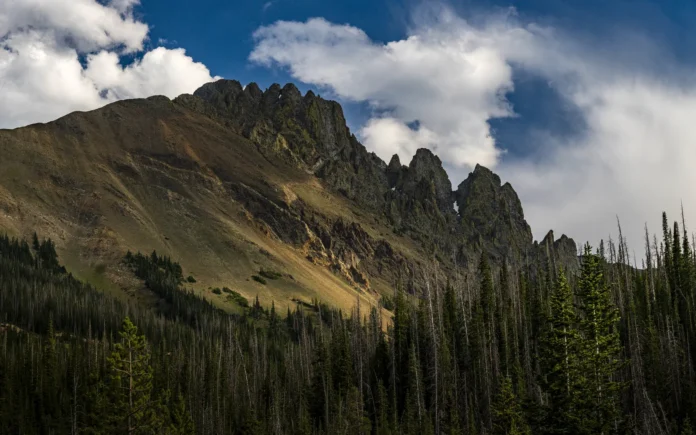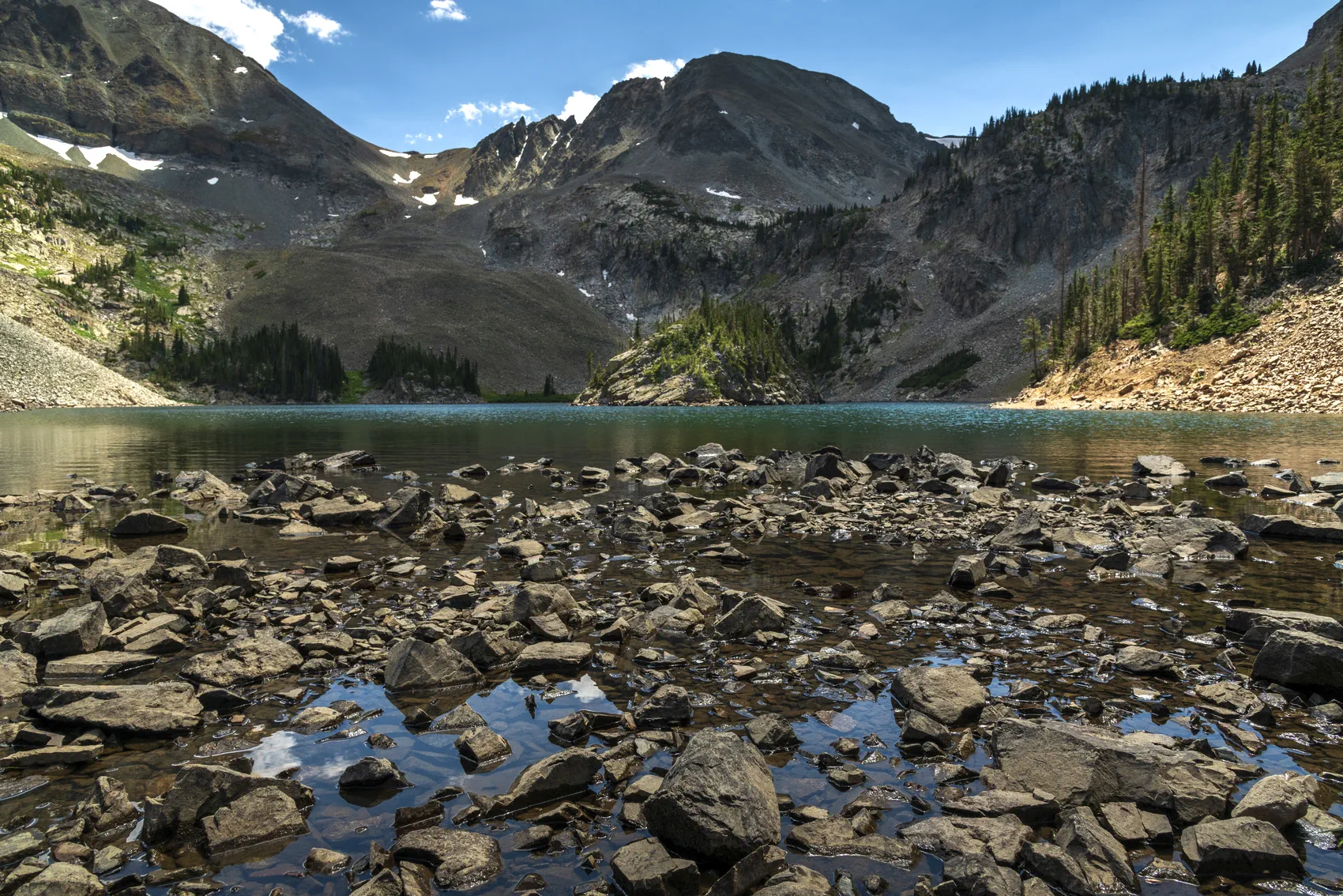High above the timberline, where the wind never quite stops and snow lingers well into summer, a jagged crown of rock dominates the northern horizon of Colorado’s Never Summer Mountains. Known as the Nokhu Crags, these serrated spires have long drawn the gaze of travelers crossing Cameron Pass on Highway 14. They are at once forbidding and magnetic, a natural fortress whose towers seem torn from the pages of a medieval epic. For scientists, historians, and adventurers alike, the Crags hold stories written in both stone and memory — stories that continue to shape northern Colorado’s identity.
A Name Carved in Language and Tradition
The name Nokhu comes from the Arapaho phrase Neaha-no-xhu, meaning “Eagle’s Nest.” To the Indigenous people who first roamed these valleys, the Crags were more than a navigational landmark; they were a spiritual sentinel, a place where the earth reached up toward the sky and the raptors circled high above.
In the 19th century, as Euro-American settlers moved into the North Park and Cache la Poudre regions, the jagged silhouette of Nokhu became part of the frontier imagination. Prospectors, trappers, and homesteaders crossing the high country could not ignore the skyline dominated by fractured spires and deep couloirs. Maps of the era sometimes reduced the feature to a simple “Crags” or “Sawteeth,” but the Arapaho name endured, echoing the sharp ridgelines that resemble the wings of an eagle mid-flight.
The Geologic Story: Born of Fire and Ice
To understand Nokhu Crags is to step back into deep time — into the Cretaceous Period, some 70 million years ago. Much of what we see today began as Pierre Shale, a marine sediment deposited when an inland sea once covered this part of North America.
But then came fire. As the Rocky Mountains were thrust upward during the Laramide Orogeny (roughly 65–70 million years ago), intrusions of granite and granodiorite forced their way through the shale. Heat transformed the surrounding layers, creating bands of metamorphosed shale that were harder, darker, and resistant to erosion.
Then came ice. Over the last two million years, during the Pleistocene glaciations, alpine glaciers gnawed at the ridges, carving deep cirques, couloirs, and talus slopes. One of those glaciers carved the bowl that now holds Lake Agnes, a jewel of blue-green water nestled beneath the towers of the Crags.
What remains after millennia of grinding is the dramatic skyline we know today — shattered towers, sheer walls, and narrow gullies where snow and ice still cling well into summer. From a distance, the Crags look invincible. Up close, climbers know better. The rock is notoriously rotten and fractured, prone to breaking loose without warning. This combination of grandeur and fragility gives Nokhu its paradoxical character: a fortress made of crumbling stone.
Lake Agnes: Gateway to the Crags
If Nokhu Crags is the crown, then Lake Agnes is the throne room at its feet. Sitting at 10,660 feet, just two miles from the trailhead, the lake is one of the most accessible alpine gems in northern Colorado.
Fed by snowmelt and small creeks, Agnes is framed by sheer walls of metamorphosed shale and the spires of Nokhu rising beyond. In early summer, the lake often remains half-frozen, its turquoise surface split by floes of melting ice. By August, wildflowers crowd its meadows — columbine, paintbrush, and alpine buttercup.
Lake Agnes has long been a destination for photographers and families seeking alpine scenery without the punishing mileage of Colorado’s fourteeners. The hike is short but steep, gaining about 500 feet in just over a mile, making it a do-able climb for most able-bodied visitors. Once there, hikers are rewarded with one of the most dramatic views in the Rockies: Nokhu Crags reflected in still waters, a natural mirror doubling the skyline.
The lake is also a launching pad for adventure. Skiers eye it in winter as the approach route to Nokhu’s couloirs. Climbers and scramblers pass its shores on their way to the ridgelines. And for casual travelers, the shoreline offers a safe and spectacular vantage point to admire the spires without venturing into dangerous terrain.
Natural Environment
The Crags rise to 12,490 feet, towering above the forests of spruce, fir, and lodgepole pine that fill the valleys. Above the treeline, alpine tundra spreads like a patchwork quilt of mosses, sedges, and hardy wildflowers. On the sheer faces, lichens paint the rock in mottled greens and oranges, a quiet reminder that life persists even in the harshest niches.
Wildlife abounds. Elk graze the meadows near Lake Agnes, marmots sun themselves on talus slopes, and pikas dart across the rocks with mouthfuls of grass for their winter caches. Above it all, golden eagles and hawks circle the Crags, fulfilling the promise of their name.
A History of Exploration
Indigenous Presence
Indigenous tribes — including the Arapaho, Ute, and Cheyenne — crossed these mountains on seasonal migrations. The Crags, like Lake Agnes, were more than physical features; they were markers in a landscape alive with meaning.
Settlers and Travelers
By the late 1800s, settlers had carved roads through Cameron Pass. The Crags became a familiar landmark, a jagged compass needle pointing skyward. Lake Agnes, meanwhile, served as a stopping point for those exploring the high basins and seeking fresh water along their routes.
Scientists and Surveyors
Geologists of the early 20th century were drawn to both the Crags and Lake Agnes. The bowl-shaped basin offered textbook evidence of glaciation, while the cliffs above revealed the violent history of metamorphism and intrusion. Today, students still visit as part of field courses, sketching cirques and couloirs much as their predecessors did.
The Adventurer’s Playground
Hiking
The Lake Agnes Trail is the entry point for most visitors. From the trailhead west of Cameron Pass, the hike is short but rewarding. At the lake, visitors can picnic, fish, or simply sit and watch the play of light on Nokhu’s spires.
Climbing
Scrambling routes from Lake Agnes lead toward Nokhu’s ridges, though climbers are quick to warn of loose shale and poor rock quality. Helmets and caution are mandatory.
Ski Mountaineering
In winter and spring, Lake Agnes becomes the staging ground for backcountry skiing. The couloirs — Three Sisters, Grand Central, Breakfast Couloir, Nokhouloir — drop directly toward the lake. Each offers 700–1,000 vertical feet of steep skiing. For seasoned mountaineers, it’s a dream — but the avalanche risk is ever-present.
Dangers and Realities
A feature on Nokhu and Lake Agnes cannot ignore the risks.
- Loose rock and rockfall hazards.
- Avalanche terrain on nearly every slope above the lake.
- Sudden weather — snow in July, lightning storms in August.
- Altitude effects — visitors unaccustomed to 10,000+ feet may find the short hike to Agnes surprisingly taxing.
Why They Matter
Together, Nokhu Crags and Lake Agnes represent the essence of the Colorado high country. The Crags are the raw geology, the sawtooth skyline, the cathedral of stone. Lake Agnes is the mirror at their feet, reflecting both their beauty and their menace. One without the other would be incomplete — but together, they offer a full portrait of the Never Summer Range.
They are a natural classroom, where geology and glaciation can be read in the cliffs and basin. They are a cultural landmark, tied to Indigenous heritage and the frontier imagination. And they are a traveler’s reward, offering both accessible alpine beauty and the lure of serious adventure.
Travel Tips
- Trailhead Access: The Lake Agnes trailhead is located off Highway 14, west of Cameron Pass. A State Parks pass is required.
- Best Seasons: July–September for hiking; March–May for ski mountaineering.
- Gear: Even for day hikers, bring sturdy boots, layers, and water. For winter travelers, avalanche gear is non-negotiable.
- Leave No Trace: Fragile alpine tundra surrounds the lake. Stay on trails and respect closures.
The Nokhu Crags and Lake Agnes form one of northern Colorado’s most iconic alpine landscapes. The spires tell a story of ancient seas, fire-born intrusions, and the grinding work of ice. The lake tells the quieter story of rebirth — of glaciers that retreated, leaving behind a jewel of water at the foot of the cliffs.
To visit is to stand between two worlds: the stability of stone and the fluidity of water, the permanence of mountains and the fleeting beauty of reflections. Whether you’re a geologist, a photographer, a skier, or a hiker, this pairing of spires and lake is unforgettable — Colorado’s Eagle’s Nest, mirrored in alpine blue.
- Wikipedia — Nokhu Crags — General facts: elevation, geology, name origin, avalanche risk, and climbing notes.
- Kiddle Encyclopedia — Nokhu Crags — Simplified location, elevation, and geological context.
- SummitPost — Nokhu Crags — Climbing routes, terrain descriptions, and natural history.
- 14ers.com Trip Reports — Firsthand accounts of climbing and skiing routes.
- 14erskiers.com — Nokhu Crags Backcountry Skiing — Details on ski descents, couloirs, and approach routes.
- Front Range Skimo — Nokhu Crags — Couloir names, ski lines, and seasonal notes.
- Newschoolers — Colorado Summer Skiing Guide: Nokhu Crags & Lake Agnes — Ski mountaineering overview and access info.
- USGS Scientific Investigations Report — Geological context, Pierre Shale and intrusive formations in the Never Summer Range.








